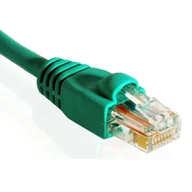In today’s digital environment, our lives are inseparable from cables. But choosing the right cable to use in various applications can be confusing.
In particular, the terms network cable and ethernet cable are often used interchangeably, leading to confusion. Here’s what you need to know about the two types of cables and how they’re different.
What Is a Network Cable?
A network cable refers to any cable that connects and transmits data between a network and computers. Different cables, such as ethernet crossover, twisted pair, coaxial, and fiber optic, are used to meet various networking requirements.
What Is an Ethernet Cable?
An ethernet cable is a type of network cable used specifically in local area networks (LAN), metropolitan area networks (MAN), and wide area networks (WAN). It connects devices such as routers, switches, and computers for data transmission and power support as power over ethernet (PoE).
Standard Ethernet cables include Categories 5, 5e, 6, 6a, and 7, with CAT 5 being the oldest and CAT 7 the newest.
CAT 5 is the standard cable for 10Base-T and 100Base-TX networks running at 10 and 100 megabits per second (Mbps). CAT 5e cables have the same basic specifications as CAT 5 cables but with crosstalk between the wires to reduce interference. CAT 6 cables are the preferred cables for 1000BaseTX networks with the ability to achieve full 1000 Mbps. CAT 6a cables are similar to CAT 6 cables but can support a bandwidth of 500 MHz. CAT 6a and CAT 7 cables offer higher performance.
Differences Between Network Cable and Ethernet Cables
Since ethernet cable is a branch of network cables, the two share some similarities. However, they also differ in various aspects.
Materials
Ethernet cables are typically made of copper or aluminum. Meanwhile, network cables encompass a range of cable types, such as electrical cable and optical fiber.
Range and Speed
Unlike other network cables, ethernet cables need to support operating speeds of 10, 100, 1,000, or 10,000 Mbps. They have combination ports to allow systems to operate at the highest speed possible for the application.
Classification
While network cables come in different configurations, ethernet cables are typically twisted-pair cables with 8P8C modular RJ45 connectors. However, newer generations of ethernet cables may use coaxial and fiber optics cables, blurring the line between ethernet cables and network cables.
Application
Different types of network cables are designed for various purposes. Patch cables are used for short distances, such as inside offices and wiring closets. Twisted pair or coaxial cables are for electrical connection within a building. Optical fiber cables are used over long distances, for high bandwidth, or in applications that require electrical isolation. In some instances, power lines can be used as network cabling.
Meanwhile, ethernet cables are typically used to connect a WiFi router or modem to an internet entry port. It may also be used to hardwire TVs, computers, and other devices to connect them to the internet or a local network.
Let Our Experts Help You
There are many similarities but also differences between ethernet and network cables. Knowing how they differ and how they’re used in various applications can help you choose the appropriate cable for your application. Still have questions about which cable is best for your unique project? JEM Electronics has more than 40 years of experience and knowledge – contact us today to speak with our expert team!



